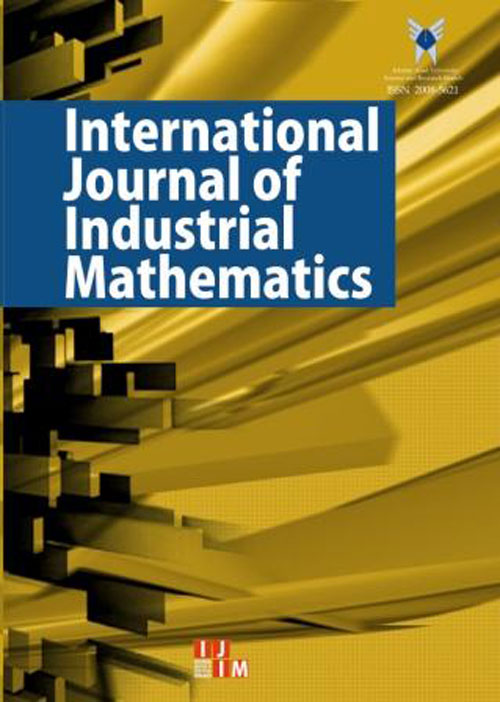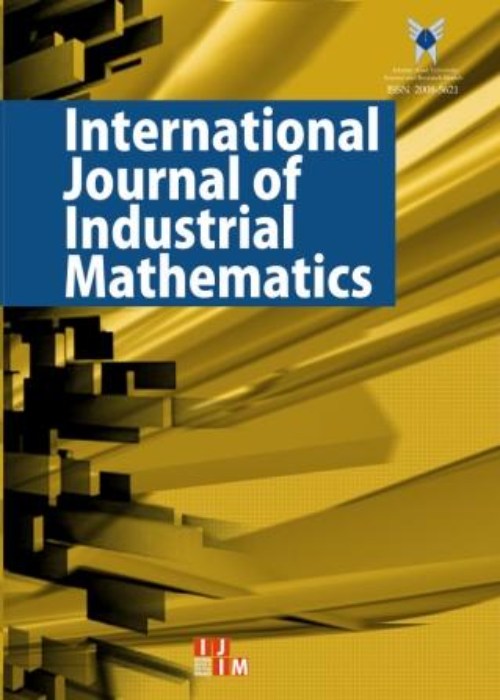فهرست مطالب

International Journal of Industrial Mathematics
Volume:10 Issue: 2, Spring 2018
- تاریخ انتشار: 1397/03/03
- تعداد عناوین: 10
-
-
Pages 115-130In this article, we investigate the measurement of performance in DMUs in which input and/or output values are given as imprecise data. By imprecise data, we mean that in some cases, we only know that the actual values are inside certain intervals, and in other cases, data are specified only as ordinal preference information. In this article, we present two distinct perspectives for determining the upper and lower bounds of the efficiency the DMU under evaluation can have with imprecise data: (1) The optimistic perspective, which uses DEA-efficient production frontier, and seeks the best score among various values of the efficiency score; the measured efficiency in this perspective is called the best relative efficiency or the optimistic efficiency. (2) The pessimistic perspective, which uses inefficiency frontier, also called input frontier, and seeks the lowest score among various values of the efficiency score; the measured efficiency in this perspective is called the worst relative efficiency or the pessimistic efficiency. For this reason and contrary to some DEA-related studies, we do not restrict our attention only to precise data. We will investigate a more general case of dealing with imprecise data, providing a method for obtaining the upper and lower bounds of efficiency. Two numerical examples will be presented to illustrate the application of the proposed DEA approach.ýýKeywords: Data Envelopment Analysis, Imprecise data, Optimistic efficiency interval, Pessimistic efficiency interval, Overall efficiency interval
-
Pages 131-142Referring to one of the recent works of the authors, presented in~\cite{differentialbpf}, for numerical solution of linear differential equations, an alternative scheme is proposed in this article to considerably improve the accuracy and efficiency. For this purpose, triangular functions as a set of orthogonal functions are used. By using a special representation of the vector forms of triangular functions and the related operational matrix of integration, solving the differential equation reduces to solve a linear system of algebraic equations. The formulation of the method is quite general, such that any arbitrary linear differential equation may be solved by it. Moreover, the algorithm does not include any integration and, instead, uses just sampling of functions, that results in a lower computational complexity. Also, the formulation of this approach needs no modification when a singularity occurs in the coefficients of differential equation. Some problems are numerically solved by the proposed method to illustrate that it is much more accurate and applicable than the prior method in~\cite{differentialbpf}.Keywords: Linear differential equation, Numerical algorithm, Triangular functions, Vector forms, Operational matrix of integration
-
Pages 143-149In this studyý, ýan efficient method is presented for solving infinite boundary integro-differential equations (IBI-DE) of the second kind with degenerate kernel in terms of Laguerre polynomialsý. ýProperties of these polynomials and operational matrix of integration are first presentedý. ýThese properties are then used to transform the integral equation to a matrix equation which corresponds to a linear system of algebraic equations with unknown Laguerre coefficientsý. ýWe prove the convergence analysis of method applied to the solution integro-differential equationsý. ýFinallyý, ýnumerical examples illustrate the efficiency and accuracy of the method.Keywords: Infinite boundary integro-differential equations, Laguerre polynomials, Operational matrix, Linear sets
-
Pages 151-164In the current work, we implement the meshless local radial point interpolation (MLRPI) method to find numerical solution of one-dimensional linear telegraph equations with variable coefficients. The MLRPI method, as a meshless technique, does not require any background integration cells and all integrations are carried out locally over small quadrature domains of regular shapes, such as lines in one dimensions, circles or squares in two dimensions and spheres or cubes in three dimensions. Weak form formulation of the discretized equations has been constructed on local subdomains, hence the domain and boundary integrals in the weak form methods can easily be evaluated over the regularly shaped subdomains by some numerical quadratures. Radial basis functions augmented with monomials are used in to create shape functions. These shape functions have delta function property. Also the time derivatives is eliminated by using two-step finite differences approximation. Two illustrative numerical examples are given to show the stability and accuracy of the present method.Keywords: Meshless local radial point interpolation (MLRPI), Radial basis function, Variable coefficient, Telegraph equation
-
Pages 165-180The present study deals with the inverse DEA using the non-radial Enhanced Russell (ER)-measure in the presence of fuzzy data. This paper proposes a technique to treat the fuzzy data in the problem of simultaneous estimation of input-output levels. Necessary and sufficient conditions are provided for ER-measure maintaining in the presence of fuzzy data. A numerical example with real data is presented to show the accuracy of the proposed method.Keywords: Data Envelopment Analysis (DEA), Inverse DEA, Fuzzy Decision Making, Multiple-Objective Linear Programming(MOLP), Enhanced Russell(ER)-Measure
-
Pages 181-192In this paper, an optimal adaptive sliding mode controller is proposed for anti-synchronization of two identical hyperchaotic systems. We use hyperchaotic complex T-system for master and slave systems with unknown parameters in the slave system. To construct the optimal adaptive sliding mode controller, first a simple sliding surface is designed. Then, the optimal adaptive sliding mode controller is derived to guarantee the occurrence of the sliding motion.Keywords: Anti-synchronization, Optimal control, Sliding mode, Barbalate's lemma, Secure communication
-
Pages 193-200The lattice Boltzmann method (LBM) has recently become an alternative and promising computational fluid dynamics approach for simulating complex fluid flows. Despite its enormous success in many practical applications, the standard LBM is restricted to the lattice uniformity in the physical space. This is the main drawback of the standard LBM for flow problems with complex geometry. Several approaches have been developed to remove this drawback of standard LBM. One of these methods is the Taylor series expansion and least squares-based LBM (TLLBM). This method is based on the standard LBM combined with the Taylor series expansion and the least squares approach. The prominent feature of the TLLBM is the fact that the final equation is an explicit form and in essence has no limitation on the mesh structure and lattice model. In the present work, the TLLBM with D2Q9 lattice model is used to simulate 2-D steady incompressible viscous flows (both internal and external) on non-uniform meshes. Four test cases are studied: (i) flow past a circular cylinder with a non-uniform O-type mesh; (ii) flow in a rectangular lid driven cavity with a non-uniform H-type mesh; and (iii) flow over a backward- facing step. It was found that this model could give very accurate results for both the internal and external flows.Keywords: Lattice-Boltzmann method, Circular cylinder, Lid driven cavity, Backward-facing step
-
Pages 201-209Supply chain management is the combination of art and science that goes into improving the supply chain. In some cases of supply chain especially two-stage process, differing weights for the same factors, may not acceptable. The purpose of this paper is a performance evaluation of two-stage using DEA and based on a CSW model and this method for ranking two-stage and could be used to measure the efficiency of two-stage.Keywords: Two-stage process, Supply Chain Management, Data Envelopment Analysis, Common set of weights
-
Pages 211-219In this paper, fuzzy variational iteration method (FVIM) is proposed to solve the second- order fuzzy Abel-Volterra integro-differential equations. The existence and uniqueness of the solution and convergence of the proposed method are proved in details. is investigated to verify convergence results and to illustrate the efficiently of the method.Keywords: Fuzzy integro-differential equations, Abel, Volterra integral equations, Fuzzy variational iteration method
-
Pages 221-228A new Schulz-type method to compute the Moore-Penrose inverse of a matrix is proposed. Every iteration of the method involves four matrix multiplications. It is proved that this method converge with fourth-order. A wide set of numerical comparisons shows that the average number of matrix multiplications and the average CPU time of our method are considerably less than those of other methods.Keywords: Moore-Penrose inverse, Iterative method, Schulz-type method, Fourth-order convergence, Matrix multiplication


